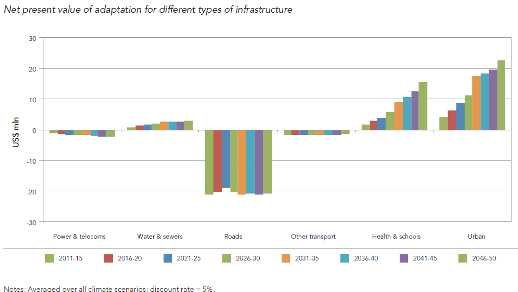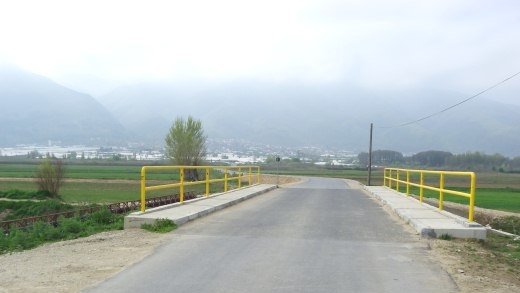Challenges of Climate Change: Vulnerability of infrastructure to weather is rising significantly because of climate change, including risks to power plants and transmission lines, telephone lines, roads, rail, airports, ports, water/sewer infrastructure, hospitals, health facilities, school buildings, municipal infrastructure, and urban storm water drainage.
Planning for the development of infrastructure assets in the context of climate change is complicated by two considerations: a wide range of projections of the future climate and a long life of the infrastructure assets, most of which cannot be easily upgraded. For example, a key factor in designing roads to cope with flooding is the amount of short-term rainfall intensity. There is a large variation in the projections, and the full range of distribution increases over time.
Although it is neither difficult nor expensive to install additional culverts to cope with higher precipitation as part of intermittent maintenance, it will be much more difficult to raise bridges or divert the route of roads to accommodate more extreme flooding or increase the size of underground sewers.
Opportunities for Green Actions: Countries with climate-resilient infrastructure that can reduce and sustain weather shocks have much lower costs of the after-shock recovery and are able to implement actions needed for the recovery in a timely fashion. Infrastructure services can be maintained into the future by applying either (i) an adaptive strategy under which new infrastructure is built in anticipation of climate change as projected; or (ii) a reactive strategy that maintains existing design standards and managing the impacts of climate change once they are realized.

In FYR Macedonia, analysis shows that upfront adaptation generates positive net benefits for some, but not all sectors. Consistently positive net benefits are observed in social sector (health and schools) and in urban infrastructure. The priorities for adaptation in the current decade should therefore include urban drainage systems, health and educational facilities, and municipal buildings.
For these infrastructure assets, design standards and operations and maintenance (O&M) practices should be modified to look ahead to projected climate conditions either 10 or 20 years ahead of the date of construction. On the other hand, the net benefits are small for 3 categories: power & telecom, water and sewage networks, and non-road transport. Also, the net benefits of upfront adaptation are consistently negative for the road sector.
Therefore, a reactive strategy of “wait, monitor, and act” is a better approach to the latter 4 categories, where enhanced maintenance and upgrades will be used to respond to future weather stresses.
The full text of the FYR Macedonia Green Growth Country Assessment can be found here.
